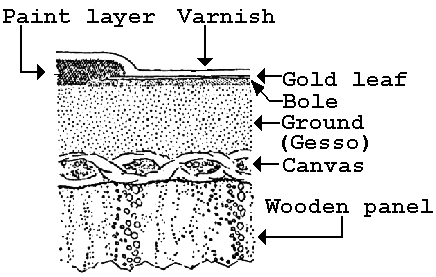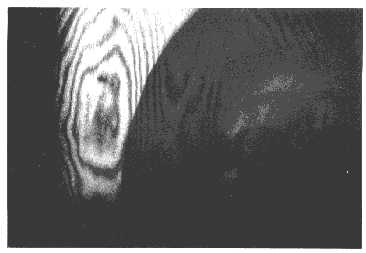
Byzantine icons were usually constituted of four layers: the wooden panel, the canvas, the paint layers (including the gilding) and finally the varnish coating (see picture below)...

The wooden panel of the painting was made of one or more boards, often of different dimensions, which were connected to each other by leaning nails. When choosing the boards artists usually preferred pieces of dry and healthy wood, without knots, cracks, signs of rot or insect pests or any kind of other flaws.This was critical for the good preservation of the icon since properly cut and well-dried boards would, to a great extent, prevent the warping of the icon. In many cases wooden cradles were nailed onto the backside of the panel in order to increase its strength, rigidity and durability and counteract its tendency to warp, curl or split.
Between the wooden panel and the preparation
ground, a piece of thick linen fabric was laid, in order to support the
paint layer during future movements of the wooden support (contraction/distinction).
Animal glue or skin glue was usually used for fixing the fabric onto the
panel.The drawing was executed directly onto the ground. This could be
a freehand design or more often a copy of a drawing from another icon.
The painter in order to give more brightness
to the colours and to protect his picture from dust, grime and light radiation
applied a varnish coating over the paint layer which was made by dissolving
or fusing a natural resin in a fluid which allowed it to be brushed over
the painting. Some natural resins used in picture have been the mastic,
dammar and sandrac.
Diagnostic systems
We are currently studying two innovative diagnostic systems to detect defects in icons; our aims are to locate detachments and cracks and to define their geometry.
At the University of Ancona research is oriented towards the characterization of defects by the study of the surface vibrations of icons; to generate such vibrations a sound wave is employed, thus avoiding any contact with the work of art. In the pictures below you can see a typical measurement set-up, speaker radiating sound not visualized, and a vibration pattern, where different colours identify different values of surface point velocity.
At A.R.T.T. researchers are more oriented towards cracks detection employing coherent optical imaging techniques. Through the use of holography they can readily visualize surface state of conservation (in the picture below note how interference fringes crowd around a crack).
